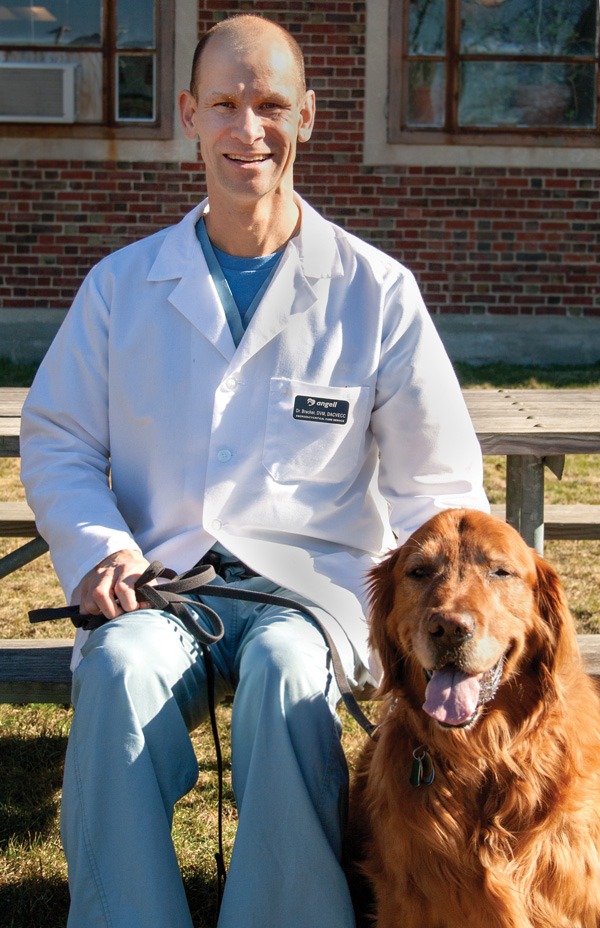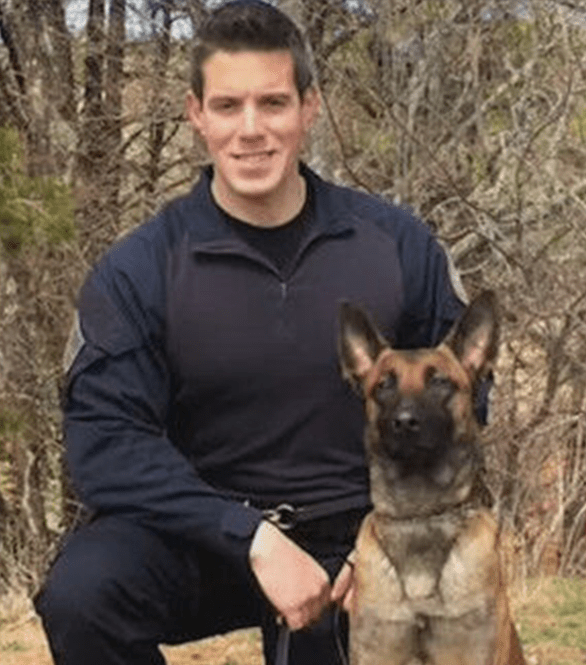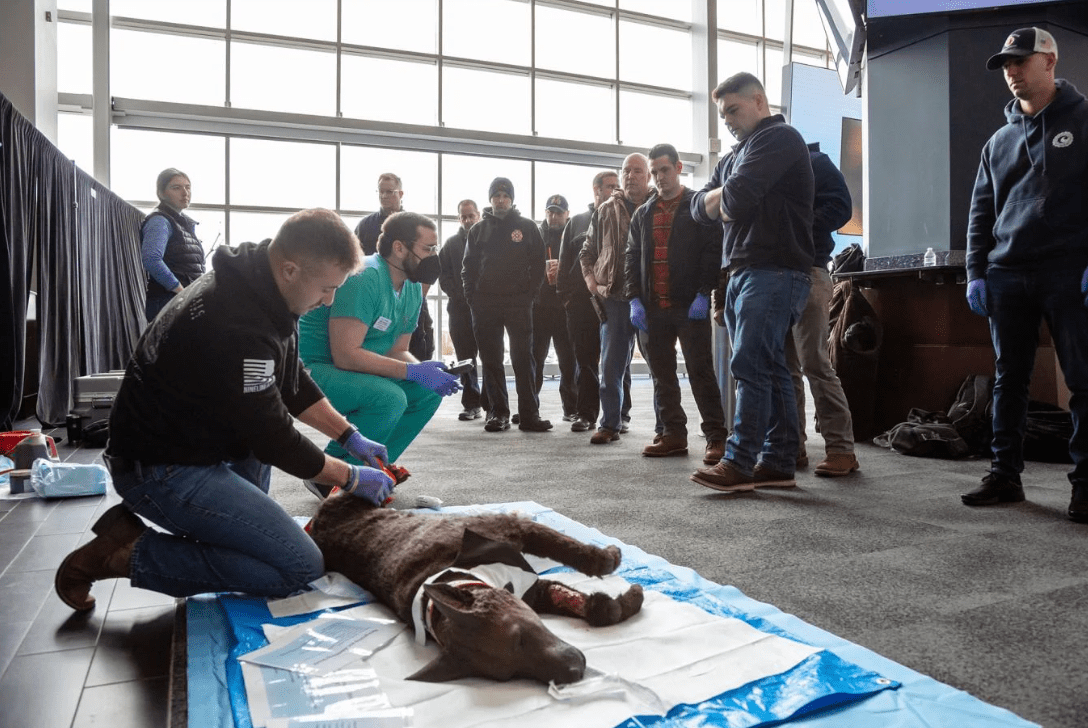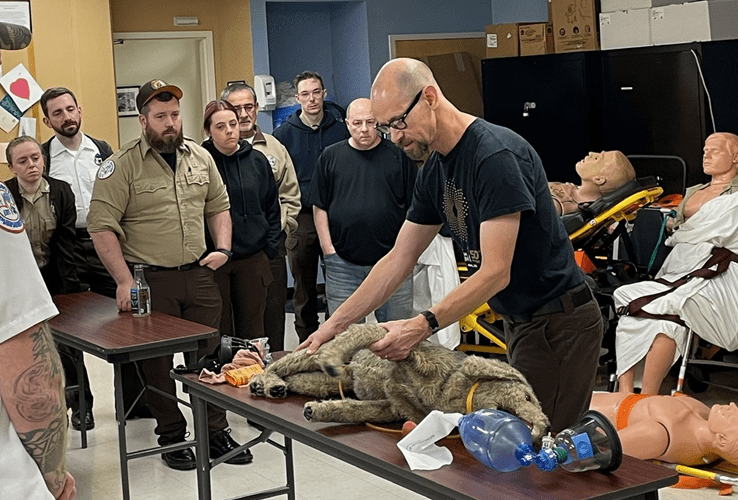-
Adopt
-
Veterinary Care
Services
Client Information
- What to Expect – Angell Boston
- Client Rights and Responsibilities
- Payments / Financial Assistance
- Pharmacy
- Client Policies
- Our Doctors
- Grief Support / Counseling
- Directions and Parking
- Helpful “How-to” Pet Care
Online Payments
Emergency: Boston
Emergency: Waltham
Poison Control Hotline
-
Programs & Resources
- Careers
-
Donate Now
 By Kiko Bracker, DVM, DACVECC
By Kiko Bracker, DVM, DACVECC
![]() angell.org/emergency
angell.org/emergency
emergency@angell.org
617-522-7282
March 2024
x
x
x
Most states do not allow EMTs (emergency medical technicians) to transport police dogs injured in the line of duty to veterinary hospitals. This was also the case in Massachusetts before the passage of Nero’s Law in February 2022.

Sargent Sean Gannon and Nero
Nero was a Belgian Malinois police dog who worked with Sergeant Sean Gannon for the Yarmouth Police Department. In April 2018, both Nero and Sargent Gannon were shot while serving an arrest warrant. Tragically, Sergeant Gannon died of his wounds, and Nero was severely injured. At the time, the Law did not allow Nero to be transported for medical care in an ambulance, so he had to be taken in a police cruiser to the nearest veterinary hospital.
It is common for states to have laws that prevent non-veterinarians from practicing veterinary medicine. However, these laws also prevent first responders (EMTs/Ambulances/fire departments) from legally transporting or treating any veterinary patients. There has been a substantial push in several states to change these laws and create training programs for human first responders so they can treat and transport injured working dogs to appropriately outfitted veterinary hospitals. This has also been the case in Massachusetts since the passage of Nero’s Law over two years ago.
Nero’s Law allows for the limited treatment and transport of working dogs owned by police departments from the site of injury to one of about a dozen hospitals across the state, including the MSPCA-Angell Boston and the MSPCA-Angell West in Waltham. These dogs may be injured while fulfilling their role as police dogs, scent detection dogs, or K-9 community resource officers. This Law does not cover working dogs owned by other agencies or the public (Seeing Eye dogs, medical alert dogs, etc.) and emotional support dogs and animals.
Nero’s Law requires that all first responders in Massachusetts must attend a half-day course (1.5 hours lecture and 1.5 hours lab) on the emergency management of canine trauma/illness. There are approximately 20,000 EMTs and firemen/women in the state who need to receive this training. The lab training sessions must be offered by veterinarians or registered veterinary technicians. So far, it has been a long time since this author has found enough trainers to satisfy the need for all these training sessions.
The lecture component of Nero’s Law training is a 90-minute online lecture completed by first responders on their own or sometimes in a group setting. This component introduces the need for and history of Nero’s Law and summarizes medical techniques that will be performed in the hands-on lab portion. The lab training is usually done at the first responders’ place of work. Four modules are presented during the lab: physical exam/assessment, restraint and handling, hemorrhage control/shock, and CPR. During their training, EMTs will practice CPR on a K-9 CPR mannequin, be introduced to an actual working police dog and their handler, use K-9-specific bandages and bandaging techniques, and perform a physical exam on a non-police dog.

Nero’s Law training session at Gillette Stadium.
The scope of medical intervention permitted under Nero’s Law remains fairly limited. The first writing of the Law aimed to allow life-saving measures and transport of an injured K-9 dog within an ambulance, but not to permit more advanced that would be better employed at the destination referral veterinary hospital. As such, first responders can bandage wounds, administer first aid, treat with epinephrine or naloxone, or perform CPR (without intubation). They are not permitted to place IV catheters, give fluid, or perform intubation and advanced life support during CPR. These limitations have proven frustrating to some EMTs with extensive medical training and enviable experience in handling emergent patients. But Nero’s Law is currently undergoing some changes in its second iteration that will hopefully allow more advanced treatments that can better take advantage of the skill set of the human first responders helping these dogs.
The implementation of Nero’s Law has been primarily organized by David Schwarz, DVM, former president of the Massachusetts Veterinary Medical Association (MVMA) and State of Massachusetts Animal Resource Team (SMART) Team Leader; Sean Majoy, DVM DACVECC, Tufts University School of Veterinary Medicine; and Jamie Falzone, MVMA executive director. They have organized multiple ‘Train the Trainer’ sessions at Tuft’s Cummings School of Veterinary Medicine and created online training opportunities through the MVMA website.
More information about Nero’s Law and Nero’s Law training sessions are available on the MVMA website (https://www.massvet.org) under Advocacy and Legislative Affairs.

Dr. Kiko Bracker of Angell’s Emergency and Critical Care service training a group of EMTs from Boston EMS.